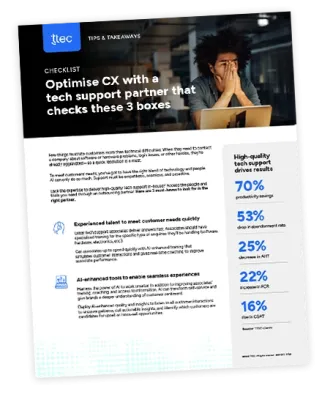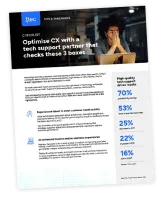For many brands, average handle time (AHT) and average talk time have traditionally been extremely important metrics. The quicker an associate can resolve a customer issue or question, the better the customer experience – or so we thought.
But as customer expectations and contact centre operations evolve, so too must our understanding of average handle time vs. average talk time. Too often, AHT and average talk time are mistakenly assumed to be the same thing. And what’s more, in the modern CX landscape, are either of these metrics even meaningful anymore?
Here are three common mistakes companies make around AHT and average talk time.
1. Confusing AHT with average talk time
For those who are going to evaluate average handle time vs. average talk time, it’s important to know the difference between the two.
Average talk time is the total average amount of time associates spend actually speaking with customers. AHT, on the other hand, is a broader term that encompasses more of the call: it includes hold time, talk time, and any post-call time an associate needs to perform wrap-up work.
This means that if brands look merely at AHT, they aren’t getting a true sense of how much time their associates spend directly interacting with customers. Conversely, paying attention only to average talk time doesn’t give a full picture of customer (or associate) experience either, since the longer AHT is more comprehensive.
2. Putting too much emphasis on AHT and talk time
As CX evolves, when it comes to the average hold time vs. average talk time debate, both are actually becoming less meaningful metrics. It’s time for companies to stop prioritising short AHT and talk times when measuring associates’ effectiveness.
Here’s why: modern customers often only call an associate when they have a complex issue or when they haven’t been able to find the solution or information they need elsewhere first. The days when customers called a contact centre as their first point of contact are over. Customers are much more likely to first seek answers via chatbots, websites, apps, and other channels. For many consumers, calling an associate is a last resort.
At the same time, intelligent automation can handle many routine tasks. Savvy brands are optimising their contact centre operations by using self-service bots, robotic desktop automation, and back-office automation to complete simple tasks, freeing associates up to focus on more complex work.
What’s all this mean? The customer inquiries and issues landing with associates are more complicated than they used to be. It’s unrealistic to expect calls to be short and quick when associates are handling these more complex interactions.
For too long, associates have been incentivised to get customers off the phone quickly, but this no longer makes sense. Associates should be rewarded for successfully resolving customers’ issues. Of course, brands and customers alike want that done as quickly as possible, but speed shouldn’t be the determining factor when evaluating associates. For a better sense of how they’re performing, look at their customer satisfaction ratings.
3. Overlooking easy ways to improve
While AHT and average talk time should no longer be the primary metrics brands focus on when assessing call centre efficiency, there can still be benefits to decreasing them.
Automation, particularly among back-office functions, can decrease AHT. When mundane tasks (things like address verification or call notes) are automated, associates can focus on the crux of customers’ issues when they get them on the phone.
When a global telecommunications company sought to cut costs in its contact centre without diminishing CX quality, we helped them reduce AHT by more than 5% in just four weeks through back-office automation. See how we did it.
Improved associate training is another way to bring AHT down. Associates who are well trained and have easy access to the information they need can better resolve customer issues quickly. When a multi-national communications provider noticed new associates struggled to handle calls from high-value customers, TTEC helped decrease AHT by 29% by developing a customised simulated learning program. See how we did it.
There are relatively simple ways brands can reduce AHT and talk time, but it’s important to remember that the average hold time vs. average handle time conversation is becoming less relevant. Companies that spend too much time focusing on these metrics may be missing the bigger CX picture.
















